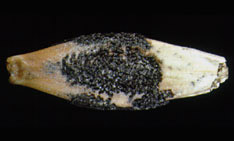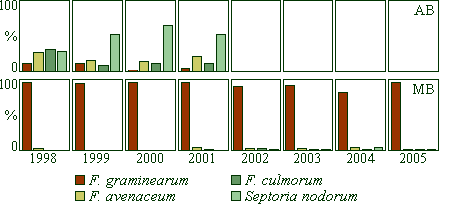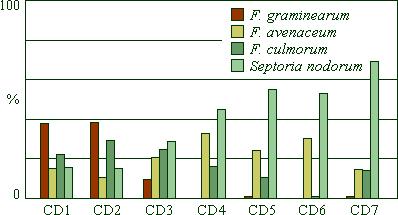![]()
Research
Fusarium head blight in western Canada
Randy Clear and Susan Patrick
Mycology, Canadian Grain Commission (CGC)
Revised January 23, 2006
Introduction
Fusarium head blight (FHB) is a fungal disease that may infect a number of crops in Canada – wheat, barley, oats, rye, corn, canary seed and forage grasses. However, the crops most affected are wheat, barley and corn.
FHB is not a new disease. It was identified over 100 years ago, in 1884, in England. It was first called wheat scab, and later, tombstone disease, because of the chalky, lifeless appearance of the infected kernels.
FHB has occurred in eastern Canada and the United States for many years. Losses from FHB in eastern Canada date to at least the early 1940's. Fusarium graminearum was first identified in Manitoba in 1923, but no serious outbreaks were reported until 1984. Since then, surveys in western Canada conducted by the Canadian Grain Commission’s (CGC) Grain Research Laboratory have found F. graminearum in an ever-expanding area, now reaching into northern British Columbia.
F. graminearum is only one of many species of Fusarium, but it is considered the most important one in Canada because of the impact it has on yield and grain quality, its ability to produce several different toxins, and its abundance in eastern Canada and the eastern prairies.
In eastern Canada, it appears to be well established in all the cereal growing areas. In western Canada, F. graminearum is found most frequently in the black soil zone. This zone is also the area of highest rainfall on the prairies. Infection is associated with rainfall during the flowering stage. The infection is spread by wind, but the pathogen is also spread by planting infected seed.
Photographs
- Seedling blight can occur when
planting infected seeds

-
Appearance of kernels with fusarium damage

-
Effects of FHB are greater the earlier
it strikes

-
Symptoms of FHB on various
grains

-
Four species in North America can cause FHB

-
F.
graminearum and Gibberella zeae

Photos courtesy of Grain Biology, Grain Research Laboratory and Mycology, Grain Research Laboratory
Seedling blight can occur when planting infected seeds
FHB results in the production of visibly damaged seeds called fusarium-damaged kernels (FDK), as well as infected seeds which don't display visible symptoms of infection. These non-symptomatic seeds usually outnumber the FDK by a considerable margin. Planting infected seeds can result in a second disease called seedling blight.
Appearance of kernels with fusarium damage
Fusarium-damaged kernels (FDK) have also been called scabby, or tombstone. These names describe the appearance of wheat kernels affected by FHB. Such kernels are shriveled and chalky white.
Effects of fusarium head blight are greater the earlier it strikes
Early  Late
[D]
Late
[D]
The earlier in the life cycle of a kernel that FHB strikes, the greater its effect. In this picture, the kernels were infected at progressively later stages of development. The three kernels on the left show what fusarium-damaged kernels look like before harvest. Much of the white fuzzy coating is lost during harvest, as shown by the three kernels on the right. Although the two kernels on the far right may appear to be normal, they are slightly infected.
Symptoms of fusarium head blight on various grains
Wheat

The four wheat seeds shown are chalky white and slightly shriveled.
Rye

The seven rye seeds shown are chalky white and slightly shriveled. One of them has a bright orange fungal structure called a sporodochia covering about one-fifth of the seed surface.
Oats

Two oat seeds are shown. One with the purplish-black, urn-shaped surface encrustation formed by Fusarium graminearum and one with the bright orange sporodochia encrusting part of the seed surface formed by a number of Fusarium species.
Barley

One barley seed with the purplish-black, urn-shaped surface encrustation formed by Fusarium graminearum.
Species of Fusarium
![]()

![]()

![]()

![]()

Four species in North America can cause FHB.

![]()

![]()

Three species in North America are routinely found to produce it.

![]()

Two of these produce DON (vomitoxin).
F. graminearum = Gibberella zeae
These pictures show two stages in the life cycle of F. graminearum. The imperfect stage is called Fusarium graminearum and the perfect stage is called Gibberella zeae. Both stages can occur together.
Sporodochia

The orange encrustation of spores called sporodochia on the wheat head.
Conidiospores
 Conidiospores are formed in
sporodochia.
Conidiospores are formed in
sporodochia.
Perithecia

Ascospores are formed in perithecia.
Asci
 Asci containing
ascospores
Asci containing
ascospores
Maps
Average level of July precipitation on the prairies, 1981-1990
FHB is most successful when rainfall occurs during the flowering stage, usually in July. This map shows the 30-year average precipitation for July in the crop districts of western Canada. Many areas of western Canada have precipitation levels in July equivalent to those of southern Manitoba, indicating that moisture levels at flowering will likely promote further westward spread of F. graminearum.
Average daily mean temperature in July
Temperature is considered a primary factor influencing species dominance in FHB. July temperatures in the western prairies are cooler than in the eastern prairies. F. avenaceum and F. culmorum are considered to be better suited to cooler conditions than F. graminearum. However, F. graminearum is the dominant FHB pathogen in the maritime provinces, where summer temperatures are cooler than on the prairies. Temperature may play a role in moderating FHB in the western prairies, although the extended daylight hours in summer in the more northern areas of the prairies may compensate somewhat for the lower daily mean temperature. One unknown is the impact of global warming on prairie temperatures and precipitation.
The distribution of F. graminearum and soil zones on the prairies
These maps show locations where F. graminearum has been recovered from FDK based on seed surveys done at the Grain Research Laboratory between 1994 and 2005. In 1994, it was mostly restricted to Manitoba and eastern Saskatchewan. By 2002, it was observed in all areas of the prairies. Most positives are in the black soil zone along the northern boundary of the agricultural area of western Canada. This area has the highest average rainfall. However, the northern areas also have lower temperatures than the southern areas and this may serve to moderate disease levels.
F. graminearum is one of four species in Canada that cause FHB and is the most important. F. graminearum had been found mostly in black soil zones, which are also areas of highest precipitation.
Graphs
- Relative frequency of
species recovered from FDK on the prairie provinces,
1998 to 2005

- Percentage of species infecting FDK
in Saskatchewan crop districts, 1998 to 2004

- Percentage of species infecting FDK
in Alberta crop districts, 2002 to 2004

- Percentage of wheat
samples containing FDK, 1998 to 2005

Relative frequency of species recovered from FDK on the prairie provinces from 1998 to 2005

These graphs illustrate the relative frequencies with which the main fungi isolated from FDK have been recovered from Manitoba in 1998 to 2005, and Alberta from 1998 to 2001. As there is a considerable difference between crop districts within Saskatchewan and Alberta, the results from Saskatchewan in 1998 to 2005, and Alberta from 2002 to 2005, are now presented below. F. graminearum continues to be the species responsible for almost all the FDK in Manitoba. F. avenaceum was the primary species from Saskatchewan until 1997, when it was replaced by F. graminearum. Septoria nodorum has traditionally been the species most often isolated from the few FDK found in wheat from the central and northern areas of Alberta. This fungus is the causal agent of glume blotch, and although it is not a species of Fusarium, it can produce a kernel visually indistinguishable from those produced by the Fusaria causing FHB. In southern Alberta, the few FDK kernels found are typically infected by Fusarium spp. Other fungi were also found infecting FDK, and they varied in frequency from 3% to 31%. The most common of these fungi was Alternaria alternata. Other important members of this category were Apiospora montagnei, Asteromella spp., F. poae, F. sporotrichioides, and Nigrospora oryzae.
Percentage of species infecting FDK in Saskatchewan crop districts
Map showing the crop districts in Saskatchewan

Saskatchewan crop districts along the southern part are numbered from 1 in the east to 4 in the west. Along the central part of Saskatchewan from east to west they are numbered 5 to 7, and along the northern part of the agricultural area from east to west they are numbered 8 and 9.
Percentage of species infecting FDK in Saskatchewan crop districts, 2005

This graph illustrates the difference in species infecting FDK in Saskatchewan in 2005. F. graminearum was the primary FHB pathogen in the eastern crop districts 1, 2 and 5. Weather in Saskatchewan was generally unfavourable to FHB development. In the western crop districts F. avenaceum was the dominant Fusarium species from FDK. FDK levels in Saskatchewan were low.
Percentage of species infecting FDK in Saskatchewan crop districts, 2004

This graph illustrates the difference in species infecting FDK in Saskatchewan in 2004. F. graminearum was the primary FHB pathogen only in crop district 1. Unusually cool temperatures throughout the growing season may have suppressed disease levels and altered pathogen ratios. In the western crop districts F. avenaceum was the dominant Fusarium species from FDK. As in 2003, FDK levels in Saskatchewan were very low.
Percentage of species infecting FDK in Saskatchewan crop districts, 2003

This graph illustrates the difference in species infecting FDK in Saskatchewan in 2003. F. graminearum was the primary FHB pathogen only in crop district 1. Dry weather in most areas of Saskatchewan resulted in very low levels of FHB, even in the eastern areas.
Percentage of species infecting FDK in Saskatchewan crop districts, 2002

This graph illustrates the difference in species infecting FDK in Saskatchewan in 2002. F. graminearum was the primary FHB pathogen in crop districts 1 and 5, whereas F. avenaceum was the dominant species in most other Saskatchewan crop districts. Unusually wet weather in normally dry areas of Saskatchewan resulted in a considerable rise in the number of samples with FDK (especially crop districts 3, 4 and 6), the majority of which were infected by F. avenaceum and S. nodorum.
Percentage of species infecting FDK in Saskatchewan crop districts, 2001

This graph illustrates the difference in species infecting FDK in Saskatchewan in 2001. The relative distribution of the causal species is very similar to that of recent years. F. graminearum was the primary FHB pathogen in crop districts 1, 2, and 5. The percentage of wheat samples with FDK in those crop districts was 58%, 14%, and 12% respectively, a considerable rise over past years. Although it was present in other crop districts, there were very few samples of wheat with FDK from outside the south-eastern corner of the province.
Percentage of species infecting FDK in Saskatchewan crop districts, 2000

This graph illustrates the difference in species infecting FDK in Saskatchewan in 2000. The relative distribution of the causal species is very similar to that of 1999. However, in 2000 F. graminearum was not dominant in crop district 2, but it was in crop district 8. Crop districts 1 and 5 continued to have the highest percentage of samples with FDK as well as the highest levels of FDK in Saskatchewan.
Percentage of species infecting FDK in Saskatchewan crop districts, 1999

This graph illustrates the difference in species infecting FDK in Saskatchewan in 1999 when tabulated by crop district. As in 1998, F. graminearum was dominant in southeastern Saskatchewan (crop districts 1, 2, and 5). Crop districts 1 and 5 had the highest percentage of samples with FDK, as well as the greatest number of FDK. F. graminearum was not the dominant species in any other Saskatchewan crop district in 1999.
Percentage of species infecting FDK in Saskatchewan crop district, 1998

This graph illustrates the difference in species infecting FDK in Saskatchewan in 1998 when tabulated by crop district. F. graminearum was dominant in south eastern Saskatchewan (crop districts 1, 2, and 5) in 1998. Those crop districts also had the highest percentage of wheat samples in Saskatchewan containing FDK (23.5%, 1.5% and 7% respectively). Although F. graminearum was also dominant in crop districts 3, 4 and 7, very few FDK were found in those areas.
Percentage of species infecting FDK in Alberta crop districts
Map showing the crop districts in Alberta

In Alberta, there are only 7 crop districts. Along the southern part, they are numbered from 1 in the east to 3 in the west. Along the central part of Alberta, they are numbered 4 and 5, and 6 is situated just above these. The crop district encompassing the northwestern part, including the Peace River area, is number 7.
Percentage of species infecting FDK in Alberta crop districts, 2005

This graph illustrates the difference in species infecting FDK in Alberta. Outside of crop districts 1 and 2 very few FDK are encountered. As in 2004, F. graminearum was dominant over F. culmorum in both crop districts 1 and 2. In the northern crop districts, the very few FDK detected were primarily caused by F. avenaceum and S. nodorum.
Percentage of species infecting FDK in Alberta crop districts, 2004

This graph illustrates the difference in species infecting FDK in Alberta. Outside of crop districts 1 and 2 very few FDK are encountered. In contrast to 2003, F. graminearum was dominant over F. culmorum in both crop districts 1 and 2. In the northern crop districts, the few FDK detected are more often caused by S. nodorum than any of the Fusarium species.
Percentage of species infecting FDK in Alberta crop districts, 2003

This graph illustrates the difference in species infecting FDK in Alberta. Outside of crop districts 1 and 2 very few FDK are encountered. F. culmorum was dominant in both crop districts 1 and 2. In the northern crop districts, the few FDK detected are more often caused by S. nodorum than any of the Fusarium species.
Percentage of species infecting FDK in Alberta crop districts, 2002

This graph illustrates the difference in species infecting FDK in Alberta. In 2002 unusually wet weather in southern Alberta resulted in a considerable increase in the number of wheat samples with FDK and the number of FDK within the affected samples. Outside of crop districts 1 and 2 very few FDK are encountered. F. graminearum and F. culmorum were dominant in crop districts 1 and 2 respectively. In the northern crop districts, the few FDK detected are more often caused by S. nodorum than any of the Fusarium species.
Percentage of wheat samples containing FDK

This graph is based on the results of the CGC's harvest surveys and shows the percentage of wheat samples containing FDK in the three prairie provinces from 1998 to 2005. In 2003, dry weather over much of the Canadian prairies during and after flowering resulted in the lowest level of FDK since 1992. There is no graph available for 2004, but FDK levels were low, although above those of 2003. In 2005, levels in the three prairie provinces were similar to those of 1999. FHB remains a minor disease in Alberta and most of Saskatchewan.
Contact
Randy Clear, Mycology
Canadian Grain Commission
Grain Research Laboratory
Telephone: (204) 983-7797
Email:
rclear@grainscanada.gc.ca
Last updated: 2006-04-18


